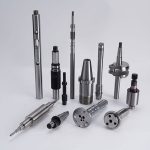Low density and high specific strength
Table of Contents
Metallic titanium has a density of 4.51 g / cm3, higher than aluminum and lower than steel, copper and nickel, but has the highest specific density of any metal.
Corrosion resistance
Titanium is a highly active metal with a low equilibrium potential and a high propensity for thermodynamic corrosion in the medium. However, titanium is actually very stable in many media. For example, titanium resists corrosion in the medium, including oxidation, neutral, and weak reducing properties. This is because the affinity between titanium and oxygen is large. In air or oxygen-containing media, a dense, strong and inert oxide film is formed on the surface of the titanium, protecting the titanium substrate from corrosion. Even if it wears mechanically, it will heal and regenerate immediately. This indicates that titanium is a metal with a strong tendency to passivate. Titanium oxide films below 315 ° C always maintain this property.
Surface treatment techniques such as oxidation, electroplating, plasma spraying, ion nitriding, ion implantation, and laser processing are being studied to improve the corrosion resistance of titanium. The titanium oxide film is for enhancing protection and obtaining desired corrosion resistance. Titanium-molybdenum, titanium-palladium, titanium-molybdenum-nickel and other corrosion-resistant titanium alloys are available for the production of metallic materials suitable for the production of sulfuric acid, hydrochloric acid, methylamine solutions, hot wet chlorine and hot chlorides. It is being developed.
A titanium-32-molybdenum alloy is used for the titanium casting. Titanium-0.3 molybdenum-0.8 nickel alloys are used in environments where crevice corrosion and pitting corrosion occur frequently. Titanium-0.2-palladium alloy was partially applied to titanium devices with good results.
- Titanium casting
- Good heat resistance
- The new titanium alloy can be used for a long time above 600 ° C.
Cold resistance
Titanium alloys TA7 (Ti-5Al-2.5Sn), TC4 (Ti-6Al-4V), Ti-2.5Zr-1.5Mo and other low-temperature titanium alloys increase in strength as the temperature decreases, but their plasticity increases. Not very big. Maintains good ductility and toughness at -196-253 ° C and avoids low temperature brittleness. It is an ideal material for cryogenic containers and storage tanks.
Strong anti-dumping performance
Titanium metal is subject to mechanical and electrical vibrations and has the longest vibration damping time of its own compared to steel and copper metals. This characteristic of titanium can be used as a tuning fork, a vibrating element for a medical ultrasonic vibrator, and a diaphragm for an advanced speaker.
Tensile strength is close to its yield strength
This titanium property exhibits a high yield strength ratio (tensile strength / yield strength), indicating that the metallic titanium material has poor plastic deformation during the molding process. Since the ratio of the yield limit of titanium to the elastic modulus is large, the repulsive force of titanium during molding is large.
Good heat transfer performance
The thermal conductivity of metallic titanium is lower than that of carbon steel and copper,
However, due to the excellent corrosion resistance of titanium, the wall thickness can be significantly reduced and the heat exchange between the surface and the vapor is droplet condensation, which reduces the heat group. Since there is no scaling of the titanium surface, heat resistance is reduced and the heat transfer performance of titanium is greatly improved.
Low elastic modulus
The elastic modulus of titanium is 106.4 GPa at room temperature, which is 57% of that of steel.
Inhalation performance
Titanium is a highly chemically reactive metal that reacts with many elements and compounds at high temperatures. Inhalation of titanium mainly refers to the reaction with carbon, hydrogen, nitrogen and oxygen at high temperatures.
Link to this article:The Marten Properties Of Titanium
Reprint Statement: If there are no special instructions, all articles on this site are original. Please indicate the source for reprinting.:Cnc Machining,Thank!^^

